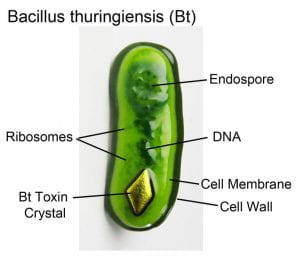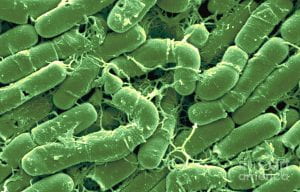What is Bacillus Thuringiensis (Bt)?
Bacillus Thuringiensis (Bt) is a microbial pesticide that acts as an insecticide (Casarett & Doull).
Watch this video to learn more about Bt.
The bacterial structure of Bt. Image link.
The microscopic structure of Bt. Image link.
Bt is commonly sprayed on plants. Image link.
Bt is a commonly used insecticide, as seen here. Image link.
Where is Bt found?
- Since Bt is a commonly used insecticide, it is commonly found in the soil where plants are treated.
Biotransformation
When Bt enters the body, it remains confined to the gut. While in the gut, it is broken down normally and excreted within 2-3 days. However, if Bt is absorbed through inhalation, it enters the respiratory system and is attacked via an immune response. After this immune response, it only takes about 1 day for Bt levels to markedly decrease. (Bacillus Thuringiensis General Fact Sheet).
Toxicokinetics
If Bt is consumed:
- When it enters the body, it is broken down similarly to the way proteins in our diet are broken down.
- When consumed, it remains confined to the gut.
- Bt is excreted within 2 to 3 days (Bacillus Thuringiensis General Fact Sheet).
If Bt is inhaled:
- Bt can move to other areas of the body including the lungs, blood, lymph, and kidneys.
- The immune system can mount a response against Bt and eliminate it.
- This process usually takes 1 day (Bacillus Thuringiensis General Fact Sheet).
Carcinogenicity
Bt has not been demonstrated to possess carcinogenic effects (Bacillus Thuringiensis General Fact Sheet).
Mechanism of Action
After an insect ingests Bt, the spores that Bt forms are solubilized and turned into active toxins in the midgut of the insect. They subsequently bind to epithelial cell receptors and insert into the cellular membrane. Next, pores are formed, and the potassium flux across the epithelial cells changes. This leads to changes in pH, causing it to become alkaline. The high pH destroys the epithelial cells of the midgut in the insect. Eventually, they die as a result of gut paralysis and feeding inhibition. Bt is selective because the alkaline conditions under which it operates is much different than the acidic environment of the human stomach (Casarett & Doull).
This video below helps visualize how the Bt toxin works.
Target organs
- In insects:
- midgut, located in the alimentary canal, of the insect.
- In humans:
- gastrointestinal system (if ingested); respiratory system (if inhaled); skin (via physical contact) (Bacillus Thuringiensis General Fact Sheet).
Signs and symptoms of toxicity
In humans and other mammals, there are little to no side effects from Bt as it has relatively low toxicity in species other than insects. Because of the low toxicity of Bt, this makes it a relatively safe insecticide to use. In some cases, Bt has been shown to cause the following symptoms (associated with acute and chronic exposure) in mammals:
- skin irritation
- eye irritation
- allergic skin reactions
- weight loss
- sleep difficulties
- stomach discomfort
- nose irritation
- throat irritation
Chronic exposure can further result in adverse immune responses.
(Bacillus Thuringiensis General Fact Sheet).
Genetic susceptibility or heritable traits
So far, there are no known genes that render humans more susceptible to the effects of Bt. This is unsurprising as Bt is relatively nontoxic and safe for humans.
Interestingly, the genes of certain crops have been altered to make them resistant to insects by incorporating Bt genes into their genomes (Ibrahim et al). Adding the Bt genes to certain crops makes them insect-resistant and helps ensure their survival.
Historical or unique exposures
One of the most controversial historical issues associated with Bt is some people have claimed that Bt is killing monarch butterflies via pollen from transgenic crops. Many people are against the use of genetically modified crops and food products, for example, crops that are genetically altered to possess Bt genes, giving them resistance against insects. However, entomologists and other researchers have claimed that the effects on the monarch butterflies are “negligible” and the transgenic pollen does not negatively impact them (Clark et al).
Treatments
In humans, there is no treatment for Bt as the digestive and/or immune system is able to handle the elimination of the toxin. Although side effects such as skin or eye irritation are limited and uncommon, they are easily managed.
Biomarkers
- There is a biomarker for Bt spore germination called calcium dipicolinate (CaDPA).
- The paper can be found here (Shu-shi Huang et al).
- CaDPA is used to characterize the spore germination process.
- This biomarker is of use in food safety.
Disclaimer: I do not own any of these images. Each image has been cited with its corresponding link.
References
- Klaassen CD, Casarett LJ, Doull J, eds. Casarett and Doull’s Toxicology: The Basic Science of Poisons. 8th ed. New York: McGraw-Hill Education; 2013.
- Bacillus thuringiensis (Bt) General Fact Sheet. http://npic.orst.edu/factsheets/btgen.html. Accessed May 18, 2019.
- Ibrahim MA, Griko N, Junker M, Bulla LA. Bacillus thuringiensis: A genomics and proteomics perspective. Bioengineered Bugs. 2010;1(1):31-50. doi:10.4161/bbug.1.1.10519
- Clarke T. Monarchs safe from Bt. Nature. September 2001. doi:10.1038/news010913-12
- PubChem. Calcium dipicolinate. https://pubchem.ncbi.nlm.nih.gov/compound/9900462. Accessed May 18, 2019.
- Shu-shi Huang, De Chen, Yong-qing Li. Detection of bacillus thuringiensis spore germination via CaDPA biomarker using laser tweezers raman spectroscopy. In: 2007 Quantum Electronics and Laser Science Conference. ; 2007:1-2. doi:10.1109/QELS.2007.4431273







